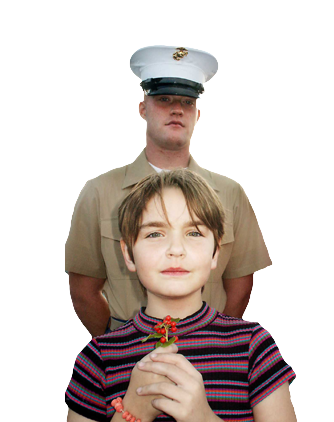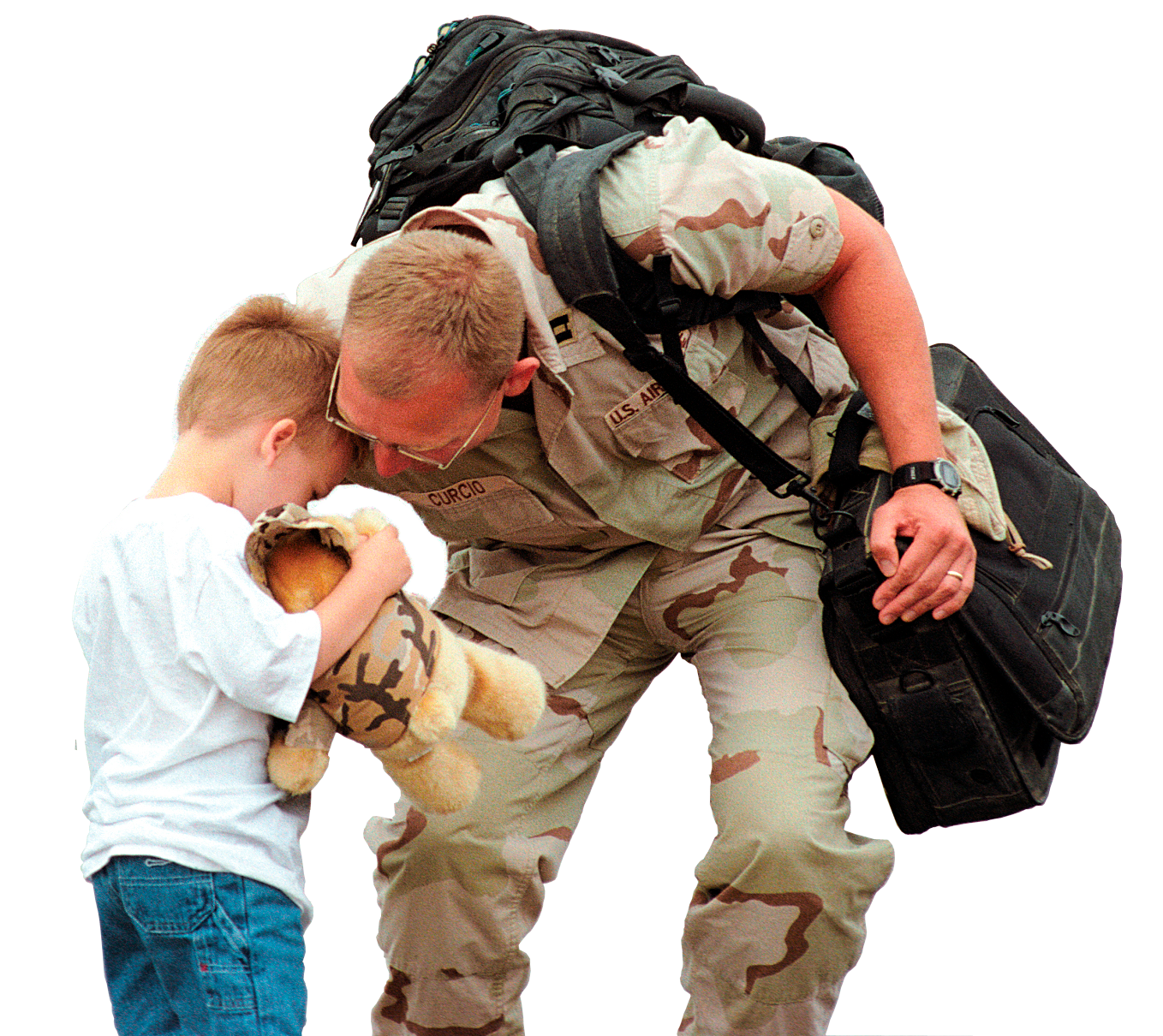Meet Your Military
- Details
- Hits: 2231
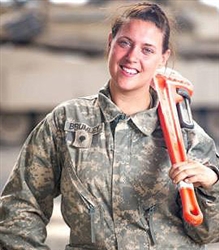 PHOTO: Army Spc. Samantha Brumley, a tank mechanic with Company F, 145th Brigade Support Battalion, Oregon National Guard, poses for a photo in front of an Abrams M1A2 System Enhanced Package tank while training at the Orchard Training Center near Boise, Idaho, Aug. 20, 2014. U.S. Army photo by Maj. Wayne
PHOTO: Army Spc. Samantha Brumley, a tank mechanic with Company F, 145th Brigade Support Battalion, Oregon National Guard, poses for a photo in front of an Abrams M1A2 System Enhanced Package tank while training at the Orchard Training Center near Boise, Idaho, Aug. 20, 2014. U.S. Army photo by Maj. Wayne
BOISE, Idaho, August 26, 2014 — Speckled with engine oil and coated with a layer of dust, 23-year-old Army Spc. Samantha Brumley rummages through a larger-than-life toolbox to begin work with her fellow tank mechanics on servicing an Abrams M1A2 System Enhancement Package Tank in the high desert area southeast from here.
Her team is at the Orchard Training Center conducting annual training in support of the 3rd Battalion, 116th Heavy Brigade Combat Team. While the service to the tank’s nuclear, biological and chemical filter system is routine, Brumley’s hands-on support is not. Brumley is the first woman to officially become a tank mechanic in the Oregon Army National Guard.
Switching military jobs
“I wanted to be a nurse. I actually wanted to be a medic when I got in, but that didn’t happen,” said Brumley, who joined the Army at age 17 as a communications specialist. She later switched jobs to become an armament repairer where she maintained and fixed weapon systems. But she wanted more.
A 2013 decision by the Pentagon opened up combat roles to women. This decision provided an opportunity to Brumley. After working near Company F tank mechanics, Brumley, who hails from La Grande, Oregon, was asked if she would like to go to school to become a tank mechanic, a role that traditionally had been held only by men.
Her response was short and direct.
“I’m not a desk-type person. I like getting hands-on. I like getting dirty. So I was like ‘Yeah, I wanna go,’” Brumley reflected.
In the spring of 2014, Brumley was on her way to a military career transition course at the Regional Training Institute in Umatilla, Oregon. “I never thought I would join the National Guard and be a tank mechanic,” Brumley said. “I certainly never thought I’d be the first woman.”
Read more: Meet Your Military: Female Tank Mechanic Likes Dirty Work
- Details
- Hits: 2128
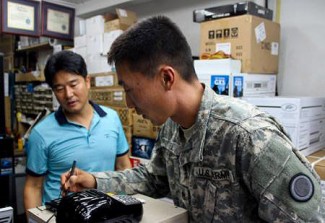 PHOTO: U.S. Army Staff Sgt. Min Sung Cha pays a vendor for a microphone at the Yongsan Electronics Market in Seoul, South Korea, Aug. 22, 2014. CAMP YONGIN, South Korea – The white Kia pulled through the gate near a fuel point at Yongsan Army Garrison in Seoul as Army 1st Lt. Jae Hyun Lee made a verbal note to no one in particular, “Okay, I can’t drive like a Korean anymore.” Cha is a Korean-American soldier assigned to Headquarters and Headquarters Battalion, I Corps, which is currently stationed at Camp Yongin, South Korea, as part of Exercise Ulchi Freedom Guardian. U.S. Army photo by Sgt. Maj. Christopher Seaton Lee, a company executive officer, and Army Staff Sgt. Min Sung Cha, the unit supply sergeant, were on a mission for Headquarters and Headquarters Battalion, I Corps. The two U.S. soldiers had just completed the 1.5-hour drive north from the unit’s life support area in Yongin, where the corps stood up for Exercise Ulchi Freedom Guardian 2014. Since the two soldiers arrived in South Korea from their home station at Joint Base Lewis-McChord, Washington, they had made several runs like these.
PHOTO: U.S. Army Staff Sgt. Min Sung Cha pays a vendor for a microphone at the Yongsan Electronics Market in Seoul, South Korea, Aug. 22, 2014. CAMP YONGIN, South Korea – The white Kia pulled through the gate near a fuel point at Yongsan Army Garrison in Seoul as Army 1st Lt. Jae Hyun Lee made a verbal note to no one in particular, “Okay, I can’t drive like a Korean anymore.” Cha is a Korean-American soldier assigned to Headquarters and Headquarters Battalion, I Corps, which is currently stationed at Camp Yongin, South Korea, as part of Exercise Ulchi Freedom Guardian. U.S. Army photo by Sgt. Maj. Christopher Seaton Lee, a company executive officer, and Army Staff Sgt. Min Sung Cha, the unit supply sergeant, were on a mission for Headquarters and Headquarters Battalion, I Corps. The two U.S. soldiers had just completed the 1.5-hour drive north from the unit’s life support area in Yongin, where the corps stood up for Exercise Ulchi Freedom Guardian 2014. Since the two soldiers arrived in South Korea from their home station at Joint Base Lewis-McChord, Washington, they had made several runs like these.
Read more: Meet Your Military: Korean-American Soldiers Bridge Cultures
- Details
- Hits: 5428
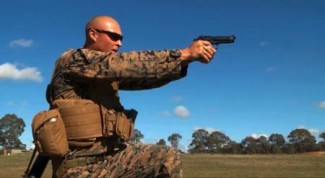 PHOTO: Marine Corps 1st Lt. Andrew H. Walker engages targets with the Beretta M9 pistol during the Australian Army Skill at Arms Meeting, May 3, 2014. PUCKAPUNYAL MILITARY AREA, Australia – It’s not a cliché: every Marine is a rifleman, regardless if they are an infantryman or an administrative clerk. Annual requirements dictate qualifying on a known-distance rifle range and the occasional field exercise, but the minimum expectations don’t inspire Marines to excellence. What, then, if a Marine has a burning passion and the drive to master the fundamentals of marksmanship? The AASAM is an annual weapons based competition where armed forces from around the globe compete against one another. Walker is the assistant logistics officer for Battalion Landing Team 3rd Battalion, 5th Marines, 31st Marine Expeditionary Unit, and a native of Raleigh, N.C.
PHOTO: Marine Corps 1st Lt. Andrew H. Walker engages targets with the Beretta M9 pistol during the Australian Army Skill at Arms Meeting, May 3, 2014. PUCKAPUNYAL MILITARY AREA, Australia – It’s not a cliché: every Marine is a rifleman, regardless if they are an infantryman or an administrative clerk. Annual requirements dictate qualifying on a known-distance rifle range and the occasional field exercise, but the minimum expectations don’t inspire Marines to excellence. What, then, if a Marine has a burning passion and the drive to master the fundamentals of marksmanship? The AASAM is an annual weapons based competition where armed forces from around the globe compete against one another. Walker is the assistant logistics officer for Battalion Landing Team 3rd Battalion, 5th Marines, 31st Marine Expeditionary Unit, and a native of Raleigh, N.C.
Walker was selected to join the Marine Corps shooting team for the AASAM as a result of his high placement during the 2014 Marine Corps Competition-in-Arms Program Western Division Matches and several years of civilian competitive shooting. Courtesy photo “My family didn’t have any guns, and aside from both of my grandfathers [who served], we weren’t a military family,” said Marine Corps 1st Lt. Andrew H. Walker, the assistant logistics officer for Battalion Landing Team 3rd Battalion, 5th Marines, 31st Marine Expeditionary Unit.
Read more: Meet Your Military: Marine Marksman Tests Skills in Australia
- Details
- Hits: 2041
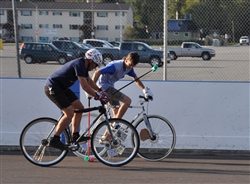 PHOTO: Air Force Staff Sgt. Jonathan MacPherson jockeys for the ball with Zachari Tate during a cycle polo game July 31, 2014, in Anchorage, Alaska. JOINT BASE ELMENDORF-RICHARDSON, Alaska – Cycle polo? What in the world is cycle polo? That's a thing? These are questions Air Force Staff Sgt. Jonathan MacPherson, a 673rd Logistics Readiness Squadron Fuels Management Flight fuels service center controller, is accustomed to hearing. Although cycle polo has been played since the early part of the 20th century, it has recently seen a surge in popularity. U.S. Air Force photo by Staff Sgt. Wes Wright A passionate competitor in the sport, MacPherson said he is happy to explain. However, what the Hoboken, New Jersey, native sometimes leaves out is the fact he has world-class talent, as demonstrated by his recent qualification to compete in the World Hardcourt Bike Polo Championships in Montpellier, France, later this month.
PHOTO: Air Force Staff Sgt. Jonathan MacPherson jockeys for the ball with Zachari Tate during a cycle polo game July 31, 2014, in Anchorage, Alaska. JOINT BASE ELMENDORF-RICHARDSON, Alaska – Cycle polo? What in the world is cycle polo? That's a thing? These are questions Air Force Staff Sgt. Jonathan MacPherson, a 673rd Logistics Readiness Squadron Fuels Management Flight fuels service center controller, is accustomed to hearing. Although cycle polo has been played since the early part of the 20th century, it has recently seen a surge in popularity. U.S. Air Force photo by Staff Sgt. Wes Wright A passionate competitor in the sport, MacPherson said he is happy to explain. However, what the Hoboken, New Jersey, native sometimes leaves out is the fact he has world-class talent, as demonstrated by his recent qualification to compete in the World Hardcourt Bike Polo Championships in Montpellier, France, later this month.
Bike polo is played in more than 30 countries, and it grows in popularity each year. MacPherson qualified to compete in the world championship after competing in the North American Hardcourt regional qualifier in July. His team was one of the top 16 qualifiers to advance to the world championship. For some people, the word polo might conjure up images of English gentlemen on horseback wielding oversized clubs -- playing what looks to be a hybrid version of hockey and golf. That's not far off the mark, MacPherson said. However, the game of polo has evolved and taken on many forms since the late 1800s. One of the more popular iterations of the sport is known as "hardcourt," typically played on a street hockey rink.
Read more: Meet Your Military: Unusual Sport Takes Airman to France
- Details
- Hits: 2098
 PHOTO: A medical group with the Danish Home Guard practices wound analysis, preparation and movement of a casualty to an aid station in Denmark, June 20, 2014. U.S. Army photo by 1st Lt. Kyle KennedySALT LAKE CITY – Through the Military Reserve Exchange Program, a computer operations officer with U.S. Strategic Command’s Army Reserve Element trained with the Danish Home Guard in Denmark. Exercises with American soldiers participating through the Military Reserve Exchange Program provide all involved with a joint training environment. “The entire trip was fun,” said Army 1st Lt. Kyle Kennedy, a Columbus, Nebraska, native. “The Home Guard liaisons made sure our days were packed from 7 a.m. to 10 p.m., and they went above and beyond to make sure we got to see the whole country and experience the Danish Home Guard way of life.” While working in Demark June 11-25, Kennedy learned how the Danish Home Guard runs its logistics, medical and armor operations, its shooting competitions, and its day-to-day activities.
PHOTO: A medical group with the Danish Home Guard practices wound analysis, preparation and movement of a casualty to an aid station in Denmark, June 20, 2014. U.S. Army photo by 1st Lt. Kyle KennedySALT LAKE CITY – Through the Military Reserve Exchange Program, a computer operations officer with U.S. Strategic Command’s Army Reserve Element trained with the Danish Home Guard in Denmark. Exercises with American soldiers participating through the Military Reserve Exchange Program provide all involved with a joint training environment. “The entire trip was fun,” said Army 1st Lt. Kyle Kennedy, a Columbus, Nebraska, native. “The Home Guard liaisons made sure our days were packed from 7 a.m. to 10 p.m., and they went above and beyond to make sure we got to see the whole country and experience the Danish Home Guard way of life.” While working in Demark June 11-25, Kennedy learned how the Danish Home Guard runs its logistics, medical and armor operations, its shooting competitions, and its day-to-day activities.
Military Reserve Exchange Program provides reserve-component officers with training associated with mobilization duties while enhancing their ability to work and communicate with service members of the host nation. “He is a unit role model and leader with impeccable character,” said Army Lt. Col. Mike Poss, commander of Stratcom’s Army Reserve Element.
Read more: Meet Your Military: Reserve Soldier Trains With Danish Home Guard




